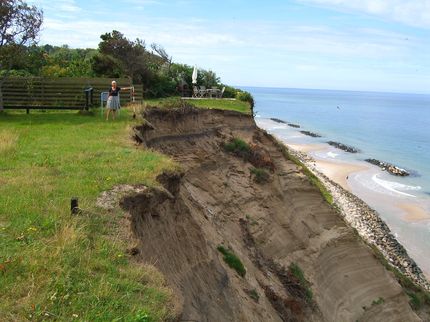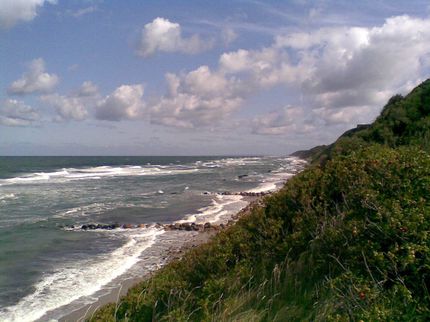The north coast of Sealand needs to be replenished with sand in order to restore its beaches and protect the coastline.
Along the north coast of Sealand, people are familiar with how the wind and the waves eat away at beaches and the coastline year by year. In many places, the sandy beach has disappeared altogether and coastal cliffs drop directly to the water's edge.
For centuries, people living along the coast have been fighting the sea, building groynes, breakwaters and cliff protection. However, their efforts have not stopped the beaches from disappearing; because, if you protect the coastline in one place, the sea merely eats up even more of the cliff elsewhere. In some places, the sea is eating away at the coastal cliff at a rate of two metres a year.
Nourishing the entire coastline with sand
This situation has led a group of homeowners to propose a common project: The coast is to be nourished with 250,000m3 of sand each year for three years and subsequently with 50,000m3 annually. This should restore the wide sandy beaches and stop the coastal cliffs from degrading.

Birgit Lund has a holiday home in the seaside town of Vejby Strand. Parts of the coastal cliff in front of her house disappeared in a landslide. A public path, named the Vincent path, disappeared with it. There was eight metres from where Birgit's stick is pointing to the cliff edge in 2005. The path was one of the few places along the north coast of Sealand where the public could walk along the coastal cliff and enjoy the view over the sea.
"The project offers a host of advantages. We will get white, sandy beaches, enabling us to bathe and walk along the beach again. Moreover, the water depth will be reduced, which will take away some of the power of the waves, so that they won't degrade the beach. And on top of this, beach feeding is a relatively cheap solution," says Jakob Wandall, who is chairman of a local homeowners association, Rågeleje-Udsholt Grundejerlag.

Many groynes and other types of 'hard' coastal protection works have been established along the coast of North Sealand in order to protect holiday homes near beaches. In many places this has made the beach disappear. The new beach nourishment project will remedy this.
More than ten thousand homeowners to help pay the bill
The cost of the project's first three years will be DKK 40 million and subsequently costs will be around DKK 3 million annually. The homeowners association proposes that the 17,000 homeowners with land situated within a distance of one kilometre from the beach are to share these costs. Homeowners closest to the coast are to pay no more than DKK 1,950 annually for three years and subsequently no more than DKK 450 annually. Homeowners furthest away from the coast are to pay no more than DKK 650 annually for three years and subsequently DKK 150 annually.
So far the project only applies to the municipality of Gribskov, but Jakob Wandall would like to encourage neighbouring municipalities to take the initiative to restore their coastlines via similar beach nourishment projects. However the municipalities of Halsnæs and Helsingør should in any case be involved in the project in the maintenance phase, because the sea is continuously moving sand along the coast from west to east.
"If expenditures for sand are shared according to the length of coastline, the municipalities of Halsnæs and Helsingør can join the project for less than DKK one million each annually; a fair price for replenishing the entire beach stretch in a municipality, wouldn't you say?" says Jakob Wandall.
The municipality of Gribskov have asked COWI, a leading northern European consultancy within engineering, environmental science and economics, to make a sketch project for beach nourishment along the municipality's shoreline. The sketch project contains two proposals for the municipality's technical committee to consider. The municipality has not taken a decision on the homeowners' financing proposal. If the beach nourishment project is adopted, the municipality will have to apply for permission from the Danish Coastal Authority, who are very enthusiastic about the project.
"This is exactly the kind of initiative that North Sealand needs, it's ambitious but realistic. For many years, houses in North Sealand have been secured using breakwaters to stop the erosion of the coastal cliff and by using other forms of hard coastal protection. This has stopped the recession of the cliff in many places, but the beaches have disappeared and with them the recreational value. The time is therefore ripe for recreating the sandy beaches and their recreational value through beach nourishment. The sand added in a beach nourishment project will reduce the water depth at the cliff base protection works, groynes and breakwaters This will ensure the stability of the hard coastal protection works in the years to come," says Per Sørensen, the Danish Coastal Authority.
The sea removes 30,000-60,000m3 of sand and stone each year from the North Sealand coast. A majority of the material ends up on submarine sandbanks east of Helsingør, from where it can be retrieved and returned to the coast.
Climate change
Sea levels have risen globally by 10-20cm over the past hundred years. The increase at Zealand's north coast, however, has only been a few centimetres, because here the land is still rising from after the last ice age. However, in the future, a rising sea level can be expected here too, and with it increased erosion. With continued relatively high levels of carbon emissions (the A2 scenario), the Danish Coastal Authority expects the coast to erode between 1.5m and 3m up to 2050. This is how much further back the coastline will recede due to climate change, if no coastal protection measures are taken.
"But if we implement the beach nourishment project, the coast will be protected against further degradation the next many years," estimates coastal morphologist Christian Helledie from COWI, who helped prepare the sketch project.
Per Sørensen adds, "Experience from this project will, along with a similar project in Northern Funen, provide us with valuable experience on using beach nourishment as coastal protection along Denmark's coastline. Experience which will be valuable when adapting the coastline to future climate change."